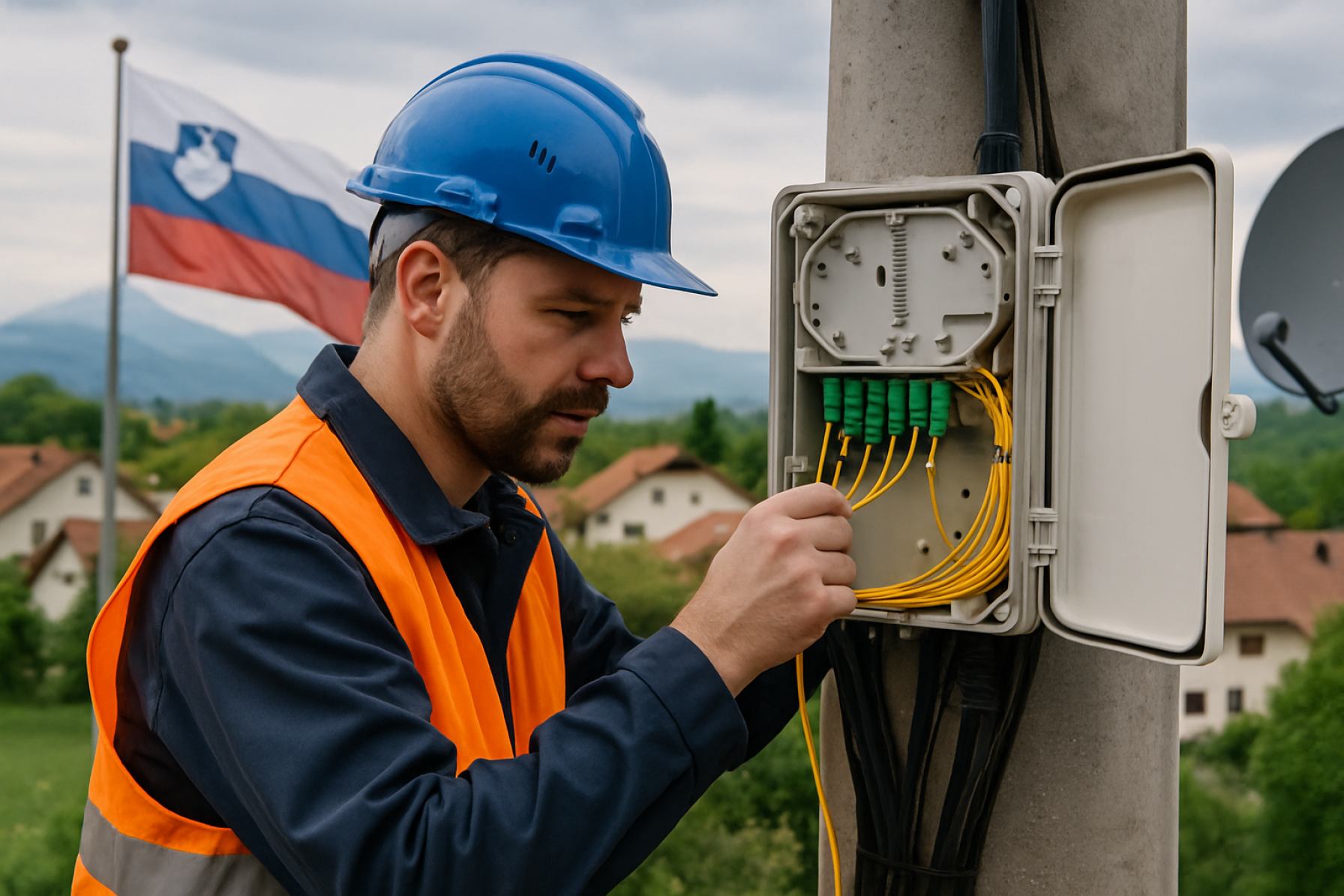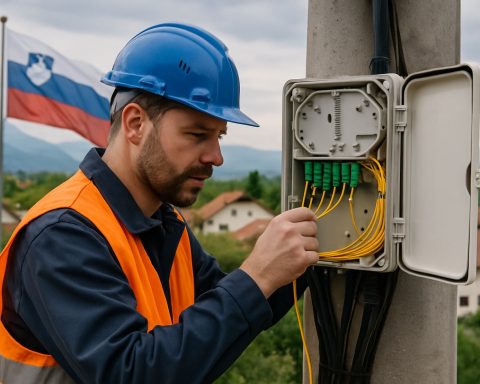Slovenia’s High-Speed Transformation: Fiber Optics, Starlink, and the Race for Next-Gen Connectivity
- Slovenia’s Broadband Landscape: Current State and Key Drivers
- Emerging Technologies: Fiber Rollouts and Satellite Internet Integration
- Key Players and Market Dynamics in Slovenia’s Connectivity Sector
- Projected Expansion and Market Growth Scenarios
- Urban vs. Rural: Regional Disparities and Access Initiatives
- What’s Next for Slovenia’s High-Speed Internet Ecosystem?
- Barriers to Progress and Strategic Opportunities Ahead
- Sources & References
“Slovenia has heavily invested in fixed broadband infrastructure, with a strong shift towards fiber-optic networks in recent years.” (source)
Slovenia’s Broadband Landscape: Current State and Key Drivers
Slovenia’s broadband landscape is undergoing a rapid transformation, marked by aggressive fiber-optic rollouts and the emergence of satellite internet options like Starlink. As of 2023, Slovenia boasts one of the highest fiber-to-the-home (FTTH) penetration rates in Central and Eastern Europe, with over 60% of households having access to gigabit-capable networks (FTTH Council Europe). This “fiber frenzy” is driven by both public and private investments, with major telecoms such as Telekom Slovenije and T-2 expanding their networks to rural and underserved areas.
The government’s Digital Slovenia 2020 strategy set ambitious targets for universal high-speed internet, aiming for at least 100 Mbps coverage for all households. By 2022, over 90% of the population had access to fixed broadband speeds of at least 30 Mbps, and 75% could access 100 Mbps or more (European Commission DESI 2023). This progress is supported by EU funding and national initiatives targeting “white spots”—areas lacking adequate connectivity.
However, Slovenia’s mountainous terrain and dispersed settlements present challenges for traditional infrastructure. This is where satellite broadband, particularly Starlink, is making inroads. Since its launch in Slovenia in 2022, Starlink has offered high-speed, low-latency internet to remote regions, with speeds often exceeding 150 Mbps (Starlink Coverage Map). While the service is more expensive than fixed broadband, it fills critical gaps for rural households and businesses, supporting digital inclusion and economic development.
Key drivers of Slovenia’s broadband makeover include:
- Government Policy: Strategic plans and subsidies to accelerate gigabit infrastructure.
- Private Investment: Telecom competition spurring rapid fiber deployment.
- EU Support: Funding from the Recovery and Resilience Facility and Connecting Europe Facility.
- Technological Innovation: Adoption of next-gen fiber and satellite solutions.
- Rural Demand: Strong push for connectivity in hard-to-reach areas.
Looking ahead, Slovenia’s broadband landscape is set for further evolution, with ongoing fiber expansion, 5G rollouts, and the growing role of satellite internet ensuring that even the most remote communities are connected to the digital future.
Emerging Technologies: Fiber Rollouts and Satellite Internet Integration
Slovenia is undergoing a significant transformation in its digital infrastructure, driven by aggressive fiber optic rollouts and the integration of next-generation satellite internet services. This dual-pronged approach is positioning the country as a regional leader in high-speed connectivity, bridging urban-rural divides and supporting the digital economy.
Fiber Optic Expansion
Slovenia’s government and private sector have invested heavily in fiber-to-the-home (FTTH) networks. As of 2023, over 60% of Slovenian households had access to gigabit-capable fiber connections, a figure expected to surpass 75% by 2025 (European Commission). Major telecom operators, such as Telekom Slovenije and T-2, are accelerating deployments, targeting underserved rural areas through public-private partnerships and EU funding initiatives. The Digital Slovenia 2027 strategy aims for universal high-speed broadband coverage, recognizing fiber as the backbone for future services like 5G, IoT, and smart city applications.
Satellite Internet Integration
While fiber networks expand, satellite internet—led by SpaceX’s Starlink—offers a complementary solution for Slovenia’s most remote and mountainous regions. Starlink officially launched services in Slovenia in 2023, providing download speeds of 100–200 Mbps and latency as low as 25 ms (Starlink Coverage Map). This has proven transformative for communities previously limited to sub-10 Mbps connections or unreliable fixed wireless. The Slovenian government has supported satellite adoption through subsidies and streamlined licensing, ensuring that no region is left behind in the digital transition.
- Rural Impact: Satellite internet is closing the digital gap for approximately 5% of the population living in hard-to-reach areas (Statistical Office of the Republic of Slovenia).
- Business and Education: High-speed access is enabling remote work, digital learning, and e-commerce, boosting economic resilience and innovation.
Looking Ahead
Slovenia’s high-speed makeover is a model for hybrid connectivity strategies. By combining robust fiber rollouts with cutting-edge satellite solutions, the country is ensuring inclusive, future-proof internet access. This digital leap is expected to accelerate GDP growth, attract tech investment, and enhance quality of life across Slovenia (OECD).
Key Players and Market Dynamics in Slovenia’s Connectivity Sector
Slovenia’s connectivity sector is undergoing a rapid transformation, driven by aggressive fiber-optic rollouts and the emergence of satellite internet solutions like Starlink. The nation’s digital infrastructure is being reshaped by both established telecom operators and new entrants, creating a dynamic and competitive market landscape.
- Fiber-Optic Expansion: Slovenia is among the European leaders in fiber-to-the-home (FTTH) penetration. As of 2023, over 60% of Slovenian households had access to FTTH, with the government targeting near-universal coverage by 2025 (FTTH Council Europe). Major players such as Telekom Slovenije, T-2, and A1 Slovenija are investing heavily in expanding their fiber networks, often leveraging public-private partnerships and EU funding.
- Competitive Dynamics: The market is characterized by intense competition, with operators vying for market share through bundled services, aggressive pricing, and value-added offerings. Telekom Slovenije remains the incumbent, but challengers like T-2 and A1 have eroded its dominance, particularly in urban and suburban areas. The entry of smaller, regional ISPs has further fragmented the market, driving innovation and customer-centric solutions (Statistical Office of the Republic of Slovenia).
- Starlink and Satellite Internet: The arrival of Starlink in Slovenia in 2023 introduced a new dimension to the connectivity landscape. Starlink’s low-earth orbit (LEO) satellite service offers high-speed internet in rural and hard-to-reach areas, where fiber deployment is economically challenging. Early adoption has been notable among remote communities and businesses requiring reliable backup connectivity (Total Slovenia News).
- Regulatory and Investment Climate: The Slovenian government supports digitalization through initiatives like the Digital Slovenia 2030 strategy, which prioritizes gigabit connectivity and digital inclusion. EU Recovery and Resilience Facility funds are accelerating infrastructure upgrades, while regulatory frameworks encourage open access and fair competition.
In summary, Slovenia’s connectivity sector is experiencing a “high-speed makeover,” with fiber-optic networks and satellite internet reshaping access and competition. The interplay between established telecoms, new entrants, and innovative technologies is setting the stage for a digitally inclusive future.
Projected Expansion and Market Growth Scenarios
Slovenia is undergoing a significant transformation in its digital infrastructure, marked by rapid fiber-optic deployment and the anticipated impact of satellite internet services like Starlink. The nation’s commitment to high-speed connectivity is evident in its ambitious targets and the influx of both public and private investments.
According to the European Commission’s Digital Economy and Society Index (DESI) 2023, Slovenia has made notable progress in fixed very high-capacity network (VHCN) coverage, with fiber-to-the-home (FTTH) reaching 70% of households, up from 60% in 2021. The government’s “Digital Slovenia 2027” strategy aims for universal gigabit connectivity by 2027, supported by over €100 million in EU and national funding for rural broadband expansion (Digital Slovenia).
Private sector players, such as Telekom Slovenije and T-2, are accelerating fiber rollouts, targeting underserved regions and urban centers alike. The competitive landscape is expected to intensify as new entrants leverage open-access networks and innovative service bundles. Market analysts project Slovenia’s fiber broadband penetration to surpass 80% by 2026, positioning the country among Europe’s leaders in digital infrastructure (Point Topic).
Meanwhile, the arrival of Starlink in Slovenia is set to complement terrestrial networks, particularly in remote and mountainous areas where fiber deployment is challenging. Starlink’s low-Earth orbit (LEO) satellite service, already available across the country, offers speeds of 100–200 Mbps, providing a viable alternative for the estimated 5–10% of households beyond the reach of traditional broadband (Speedtest Global Index).
- Optimistic Scenario: By 2027, Slovenia achieves near-universal gigabit coverage, with fiber and satellite bridging the digital divide. The digital economy flourishes, attracting tech investment and fostering innovation.
- Moderate Scenario: Fiber expansion slows in the most remote areas, but Starlink and other LEO providers fill the gap, ensuring 95%+ high-speed coverage. Urban-rural disparities narrow, though some challenges persist.
- Pessimistic Scenario: Regulatory or funding delays hinder rollout, leaving rural communities reliant on slower connections. Market fragmentation and affordability issues limit uptake of advanced services.
Overall, Slovenia’s high-speed makeover is poised to reshape its digital landscape, with fiber and satellite technologies working in tandem to deliver robust, future-proof connectivity nationwide.
Urban vs. Rural: Regional Disparities and Access Initiatives
Slovenia is undergoing a significant transformation in its digital infrastructure, aiming to bridge the urban-rural divide through a combination of fiber-optic expansion and satellite internet solutions. The government’s ambitious “Digital Slovenia 2020” strategy set the groundwork for widespread high-speed internet access, with a particular focus on underserved rural areas. As of 2023, Slovenia’s fixed broadband coverage reached 98% of households, but only 86% of rural households had access to networks capable of delivering at least 100 Mbps, highlighting persistent regional disparities (European Commission).
The “fiber frenzy” is most visible in urban centers like Ljubljana and Maribor, where gigabit-capable fiber-to-the-home (FTTH) networks are rapidly expanding. Operators such as Telekom Slovenije and T-2 have invested heavily in fiber rollouts, resulting in urban gigabit coverage rates exceeding 90% (Telekom Slovenije). However, the high cost of deploying fiber in sparsely populated rural regions has slowed progress, leaving some communities reliant on legacy copper or mobile broadband solutions.
To address these gaps, Slovenia is embracing next-generation satellite internet, notably through partnerships with providers like Starlink. In 2023, Starlink began offering services across Slovenia, providing rural households with download speeds of 100–200 Mbps and latency as low as 20 ms (Starlink Coverage Map). The government has supported these initiatives with subsidies and regulatory simplification, aiming to ensure that even the most remote villages can participate in the digital economy.
Despite these advances, challenges remain. The cost of Starlink hardware and subscriptions can be prohibitive for some rural residents, and digital literacy gaps persist. Nevertheless, Slovenia’s dual approach—accelerating fiber deployment in urban areas while leveraging satellite technology for rural connectivity—positions the country as a regional leader in digital inclusion. Ongoing public-private partnerships and EU funding are expected to further narrow the urban-rural digital divide by 2025 (Government of Slovenia).
What’s Next for Slovenia’s High-Speed Internet Ecosystem?
Slovenia’s high-speed internet landscape is undergoing a rapid transformation, driven by aggressive fiber-optic rollouts and the arrival of next-generation satellite connectivity. As of 2023, Slovenia boasts one of the highest fiber-to-the-home (FTTH) penetration rates in Central and Eastern Europe, with over 60% of households having access to gigabit-capable networks (FTTH Council Europe). This “fiber frenzy” is the result of both public and private investments, including EU-backed initiatives targeting rural and underserved areas.
Major telecom operators such as Telekom Slovenije and T-2 have accelerated their fiber deployments, aiming to cover nearly the entire population by 2025. The government’s Digital Slovenia 2027 strategy further supports this momentum, with a goal of universal access to at least 100 Mbps broadband and a strong push for 1 Gbps connections in urban centers (Digital Slovenia).
However, the next phase of Slovenia’s high-speed makeover is unfolding above the clouds. In 2023, Starlink officially launched its satellite internet service in Slovenia, offering download speeds of 100–200 Mbps even in the most remote Alpine villages. This has been a game-changer for rural communities, where fiber deployment is often economically unfeasible. Early adoption rates are promising, with Starlink subscriptions growing steadily and complementing terrestrial networks rather than replacing them (Total Slovenia News).
Looking ahead, Slovenia’s high-speed internet ecosystem is expected to become a hybrid model, blending ultra-fast fiber in urban and suburban areas with satellite solutions for hard-to-reach regions. The government is also exploring 5G fixed wireless access as another layer of connectivity, aiming to ensure no citizen is left behind in the digital transition (Slovenian Government).
- Fiber expansion will continue, targeting 90%+ coverage by 2025.
- Starlink and other LEO satellites will bridge the rural gap, with regulatory support for seamless integration.
- 5G FWA pilots are underway, promising additional redundancy and speed.
Slovenia’s digital future is bright, with a multi-technology approach ensuring robust, resilient, and inclusive high-speed internet for all.
Barriers to Progress and Strategic Opportunities Ahead
Slovenia’s digital transformation is accelerating, but the journey from fiber-optic expansion to next-generation satellite connectivity faces notable barriers—and presents strategic opportunities. The country’s ambitious “fiber frenzy” has seen rapid deployment of gigabit broadband, with over 70% of households now passed by fiber networks as of 2023 (European Commission). However, the last mile remains a challenge in rural and mountainous regions, where high deployment costs and complex terrain slow progress.
Regulatory hurdles also persist. While Slovenia’s government has streamlined some permitting processes, local bureaucracy and fragmented municipal policies can delay network rollouts (Government of Slovenia). Additionally, the market is dominated by a few large players, limiting competition and innovation in both pricing and service offerings.
Yet, strategic opportunities abound. The arrival of low-Earth orbit (LEO) satellite services like Starlink is a game-changer for Slovenia’s digital inclusion. Starlink’s coverage now extends across the country, offering high-speed internet to remote areas previously underserved by terrestrial networks (Starlink Coverage Map). This leapfrogs traditional infrastructure barriers and supports national goals for universal broadband access by 2025.
Furthermore, Slovenia’s position as an EU member unlocks access to significant funding streams, such as the Recovery and Resilience Facility, which earmarks over €300 million for digital transformation projects (European Commission: Slovenia’s Recovery Plan). These funds can be strategically directed to subsidize rural connectivity, foster public-private partnerships, and incentivize innovation in 5G and IoT applications.
- Barriers:
- High costs and logistical challenges in rural fiber deployment
- Regulatory fragmentation and slow permitting
- Limited market competition
- Opportunities:
- Starlink and other LEO satellites bridging the digital divide
- EU funding for digital infrastructure and innovation
- Potential for Slovenia to become a regional testbed for advanced connectivity solutions
In summary, while Slovenia’s high-speed makeover faces structural and regulatory barriers, the convergence of fiber and satellite technologies, coupled with strategic investment, positions the country to achieve digital leadership in Central Europe.
Sources & References
- Slovenia’s High-Speed Makeover: From Fiber Frenzy to Starlink Skies
- FTTH Council Europe
- European Commission: Slovenia’s Recovery Plan
- Starlink Coverage Map
- Government of Slovenia
- Statistical Office of the Republic of Slovenia
- T-2
- A1 Slovenija
- Total Slovenia News
- Point Topic
- Speedtest Global Index








